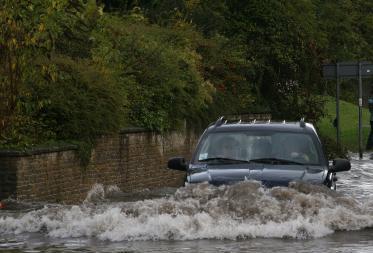The state, insurers and people living in risk areas all have a role to play in flood protection

The future model for UK flood insurance should involve greater participation from government, insurers and policyholders, (re)insurers believe.
Flood insurance is only available under the Statement of Principles between insurers and government. It expires in June next year and Defra needs to make a decision about its future by the end of this month.
Swiss Re’s director of specialty Dr Jens Mehlhorn, in London this week ahead of the launch of the reinsurer’s ‘Flood and Underestimated Risk’ report, said he still believed flood was an insurable risk, but criteria within that risk needed to be met.
UK has best system
A spokesman for Munich Re said that while the reinsurer could not comment on decisions to be made by government ministries or the outcome of ongoing negotiations between market participants, its experience was that the private insurance industry was proven to efficiently address natural catastrophe risks, for example, by pool-type solutions.
‘The first priority of the state is to provide protection to their citizens by finding the most cost-effective protection measures
Dr Jens Mehlhorn, Swiss Re
Mehlhorn said that the UK had one of the best flood insurance systems compared to other parts of the world where cover was optional.
“People who know they are exposed to flooding typically buy flood insurance, but those who live further away don’t always think they are exposed. But they can be, as we saw in 2007 with the flash flooding in the UK,” he said.
Highest premiums – but also state protection
Mehlhorn said the problem arose when those people living in a high risk area benefited over-proportionately from the system by getting flood cover at a low premium that didn’t reflect their risk.
He said it was only right for those living closer to rivers and were more often affected to pay higher premiums, while those who were extremely exposed should receive help from the state in terms of flood protection.
“If you have a flood loss every 10 years of around £20,000, that would require a premium of about £2,000 a year, which is already quite high,” he said.
“My point of view would be that the first priority of the state is to provide protection to their citizens by finding the most cost-effective protection measures. If that is done well, insurance becomes affordable and can play a role.
“For those who have extremely high risk, I would say it’s the duty of the state to reduce the risk and then get coverage from the insurance industry.”
No more flood-plain developments
Mehlhorn said that those living in areas which were affected by flooding every 30 years or less should take out cover.
“At the end of the day it’s a public private partnership, so all parties involved have to do their part, with the state investing in flood insurance, the insurance industry investing in flood insurance and providing protection at an affordable level, and the insured mitigating the risk through the use of sandbagging and ensuring that they don’t have any valuables on the ground floor,” he said.
Mehlhorn said government had to ensure that were no new building developments on flood plains while either providing a subsidy to the overall premium or investing in flood insurance in high risk areas.
Maintaining the model
With the deadline looming for the Statement of Principles to be resolved, Mehlhorn is keen to for the UK flood insurance model to be maintained.
He said that while insurers could control the service fee they charged, the issue was the risk premium and government needed to step in to lower it.
Flooding has devastated parts of the UK, including Wales and the South West, in recent weeks and Mehlhorn believes the risk of flooding is increasing, not least because of climate change.
The worst case scenario for the UK, he said, would be a storm surge that caused the Thames barrier to fail, resulting in a $20bn-plus loss.
Thai floods took industry by surprise
Although the UK floods were not a major event for reinsurers, Mehlhorn said that those in Thailand had taken the industry by surprise because of the large areas of exposure that had built up over the past five to 10 years, most of which was financed by foreign investment.
Most of the $12bn losses came from international business insured in Japanese treaties and contracts.
Mehlhorn said Swiss Re had subsequently conducted a study into emerging countries to find out which were the most exposed, looking at GDP growth over the last 10 years, foreign direct investment and flood exposure.
The BRIC countries (Brazil, Russia, India and China) came out top, with China leading the way and Thailand at number seven. China was found to have strong GDP growth, a lot of investment and a significant flood risk.
Mehlhorn said a one in 50 year event in China would have the potential to cause the same or larger losses than the Thai floods.





































No comments yet